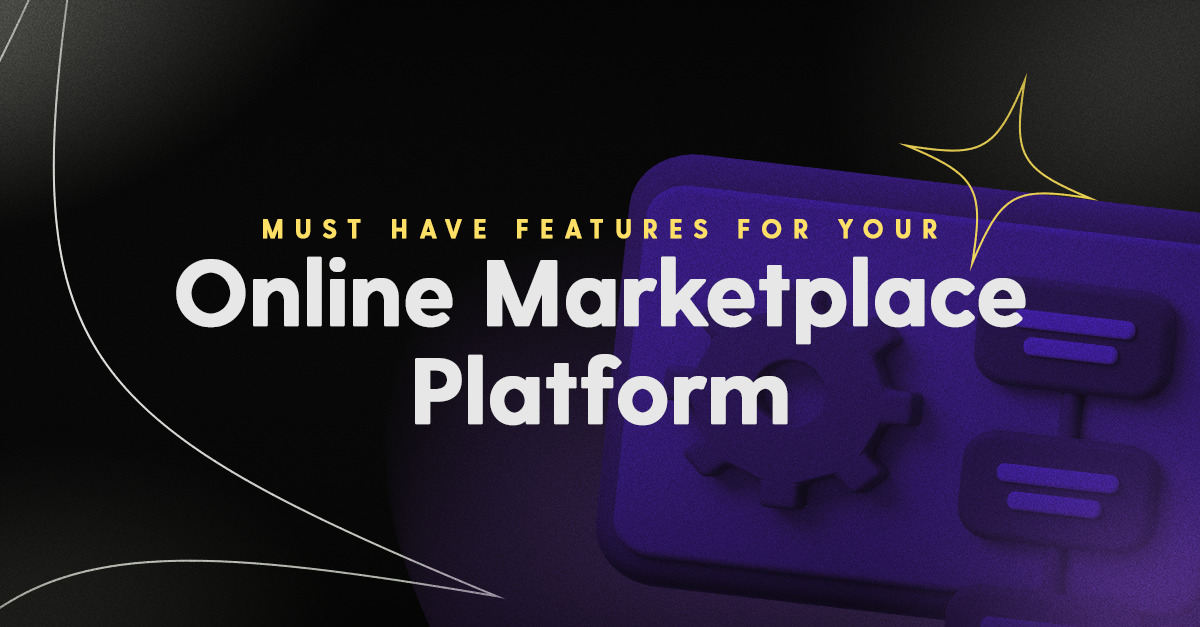Thinking of building an online marketplace? You’re not alone.
In 2023, there were more than 10,000 new marketplace businesses launched.
Question: why is building a marketplace so popular?
Answer: Online marketplaces have highly scalable & high margin business models. They also provide access to a much higher audience when compared to single ecommerce stores. Digital buyers also prefer shopping from marketplaces as they get more choice to pick from.
83% of U.S. power shoppers said online marketplaces are the most convenient way to shop.
digitalcommerce360
Whether you’re the owner of an existing online marketplace or planning to start a new one, there are key features that every marketplace should have.
In this article I am going to break down the top must have features that absolutely every online marketplace must have from day one.
Marketplace Insider Tip
Building an online marketplace can feel overwhelming. There are lots of features, different business models, finding users and growing your marketplace.
It’s impossible to do everything all at once – especially when you’re on a limited budget.
For the best chances of success, we recommend starting off by understanding how our marketplace template works and then adding features incrementally to this based on your unique use case and user feedback.
Top features every online marketplace must have from day one
There is so much information online on how to build a marketplace business. 99% of this information has been created by people who’ve never actually developed a successful online marketplace.
At Dittofi, we’ve built over 100 successful marketplaces. In doing so we have learnt what are the absolutely essential features required to build an online marketplace.
In the rest of the article, we break down a list of must-have marketplace features & we take a deep dive into the technological, design & business nuances that you need to consider to successfully develop each of the different features.
The features we look at include:
1. Buyer & seller landing pages
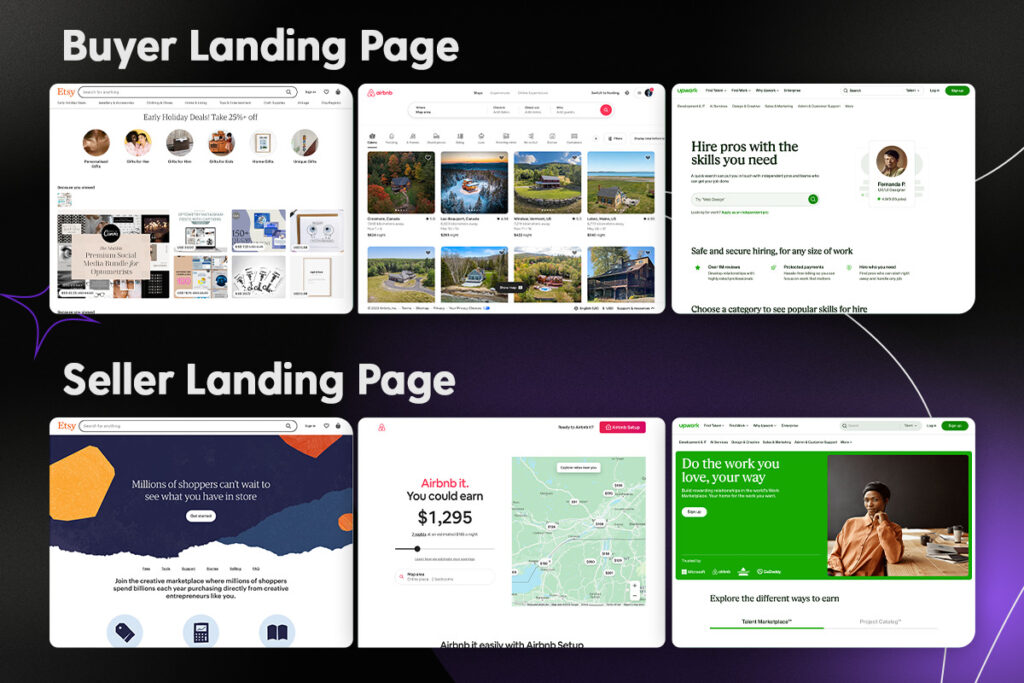
Each of the landing pages shown above are structured similarly.
At the top of each of the buyers’ pages is the navigation bar. This provides options to quickly explore the marketplace, sign up, login & to become a vendor. Below the navigation is the hero section. This contains a clear value proposition with a call to action. The buyers landing page should also display product & service listings with high resolution images, reviews, as well as platform benefits, customer testimonials & footers.
Marketplaces with many different categories of products or services tend to create multiple landing pages for different categories. These landing pages are optimised for search engines. This is so that when customers are searching for a particular product or service they will land on a highly targeted landing page. For instance, below is an example of two landing pages for the freelance marketplace Upwork. The first is designed to capture users looking for software developers & the second for users looking for graphic designers.
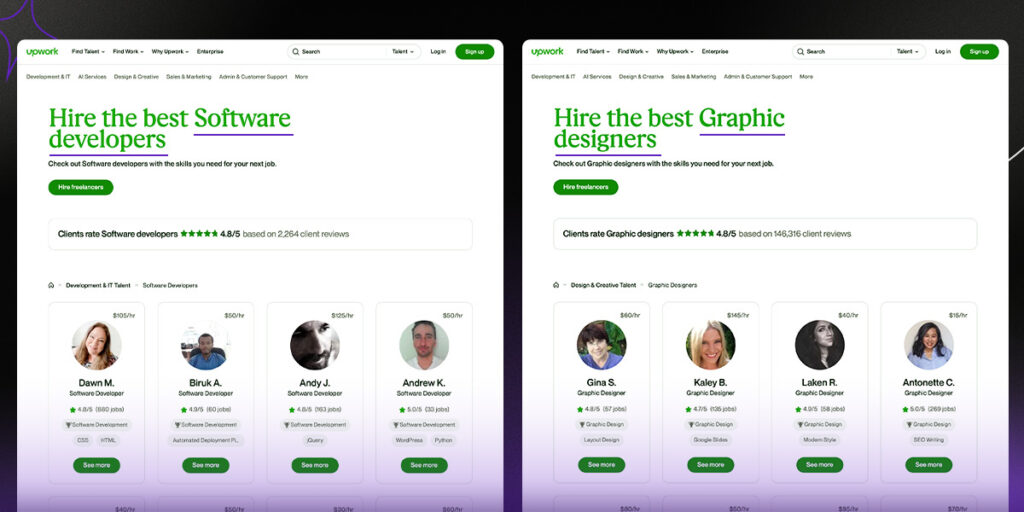
Marketplaces that offer location specific products or services such as Airbnb, may also create landing pages targeting specific locations.
To build pages like this, you need a strong technology that allows you to automatically replicate the landing page designs, with variable information & that are optimized for search engines (more on this later).
The seller’s landing page also has a navigation bar at the top. Below this, there is the hero section that contains a value proposition that is targeted towards sellers. The sellers landing page then displays information to help sellers make the decision to list their products or services. This includes information such as core features of the marketplace that benefit sellers, seller / buyer testimonials, options to get support from more seasoned sellers, a breakdown of the costs charged by the marketplace and any frequently asked questions. At the bottom of the page is a footer.
As a marketplace operator, it can be overwhelming to search for both buyers & sellers simultaneously. This is why we recommend picking a niche product or service & focus initially on developing a landing page that will attract either the buyer or seller.
To learn more about attracting buyers & sellers, read our article, how to solve the chicken and egg problem.
2. User onboarding
Every marketplace has two types of users: buyers & sellers. Both buyers & sellers need to be onboarded differently. A good example of this is Airbnb which has different onboarding screens for renters & property owners.
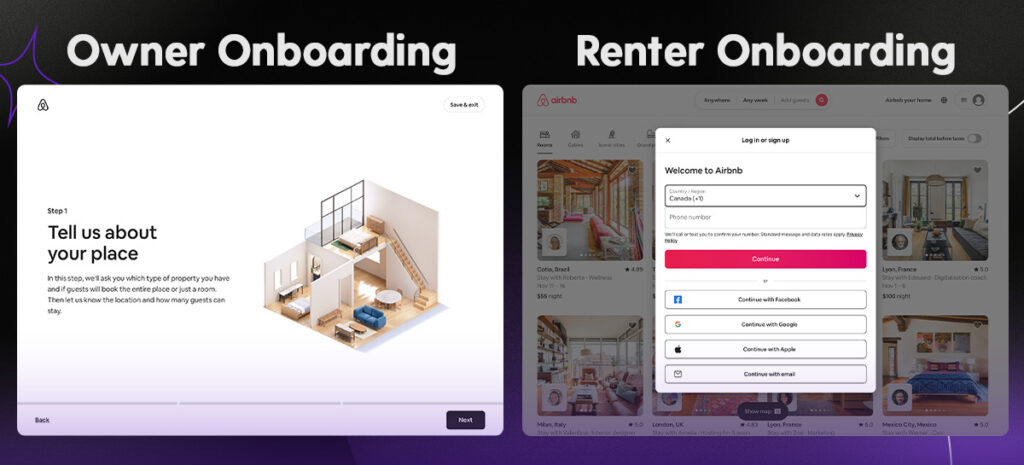
As you can see, renters are required to provide only their first name, last name, email & password, whereas the property owners are onboarding using multiple forms where they are asked to provide information on their property listings.
When designing your onboarding forms there are a couple of things to consider:
- What information do you actually need? You need to think about what is the minimum amount of information you need to collect. The more forms that a user needs to fill in, the more likely they are to give up & leave your marketplace.
- When do you want to ask for the information? You don’t need to ask for all of the information upfront. For example, Airbnb lets guests sign up with just their first name, last name, email & password. Once the guest has found a property that they want to rent, Airbnb asks the guest to upload a screenshot of their passport. The idea is that the guest is more likely to upload a copy of their passport once they’ve found a property that they actually want to stay in.
- How do you ask for information? One of the simplest ways to ask for the information is with the use of single sign on technology. For example, sign up with Google, sign up with Facebook, sign up with Twitter etc. By adding these buttons to your sign up process helps streamline the process of capturing user information and promotes trust in your marketplace.
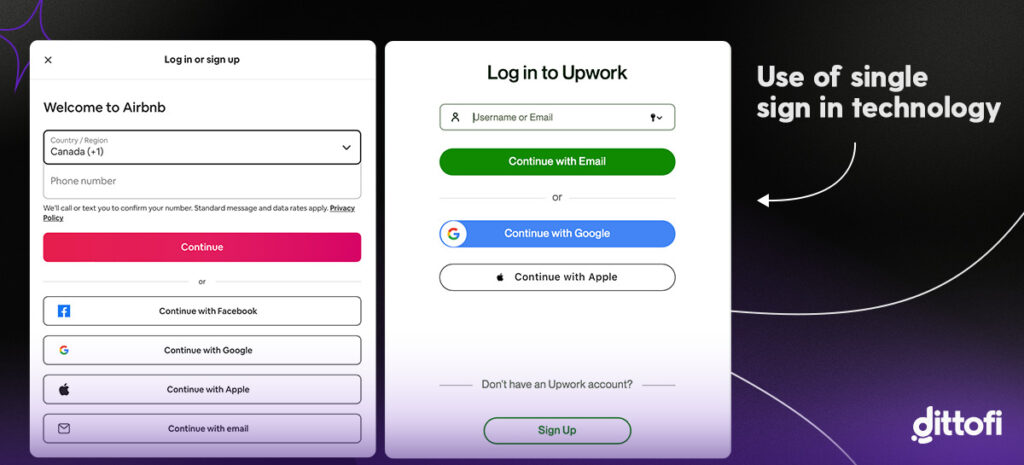
Dittofi has developed prebuilt sign up and onboarding screens for marketplace buyers and sellers. Each form can be customized from within Dittofi’s visual development studio without writing any code. The screenshot below shows some examples of the onboarding screens inside Dittofi Travel, a template marketplace like Airbnb.
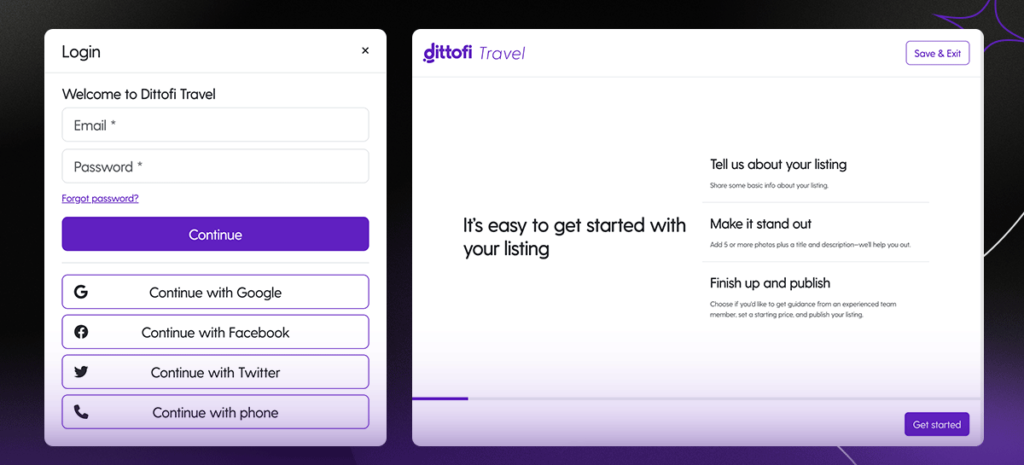
3. Easy search and navigation
Online marketplaces have lots of products and services.
To help buyers efficiently navigate your marketplace you need to organize your products & services into different categories. For example, consider the product marketplace Etsy. As you can see on the screenshot below there are three levels of categories, the top level category “jewelry”, and then there is the subcategory “Accessories” and then the sub-subcategory “Belts & Braces”.
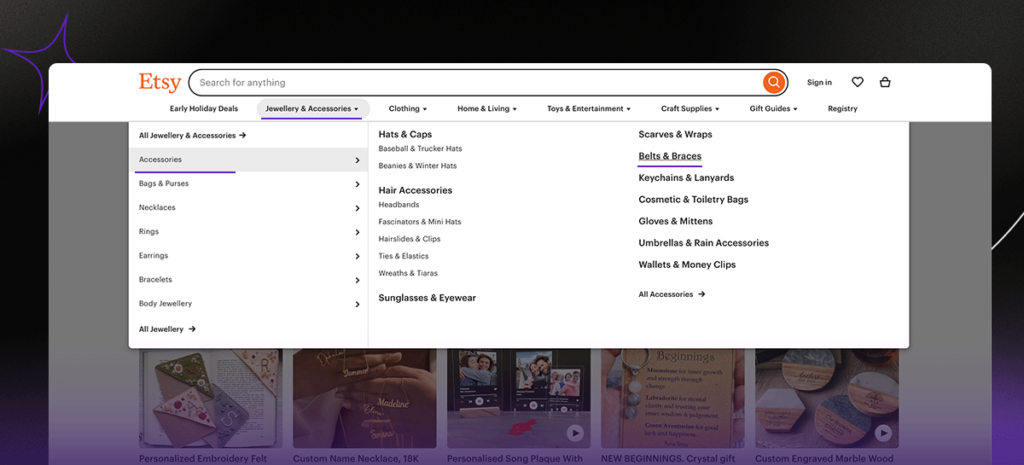
You should also be able to create new, temporary categories. This is important because it allows you to categorise products into promotional offers which can help to drive sales. For example, Etsy has promotional categories that are seasonal such as Autumn Décor & Halloween Finds (example below). Other marketplaces also create temporary categories such as Airbnb who promote “holidays in the sun” in the winter & Fiverr who promote “Freelancer of the month”, “Popular services” and so on.
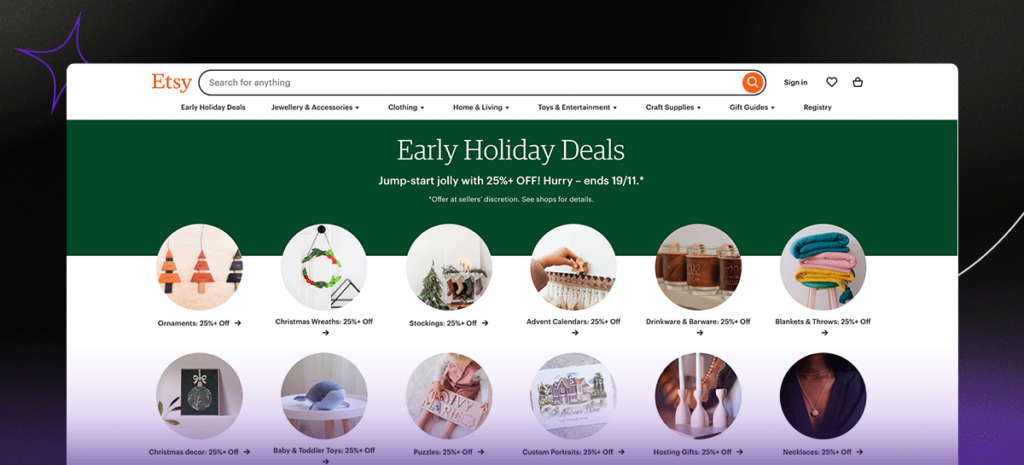
Being able to create promotional categories means that it is very important that you choose a technology that allows the flexibility to create temporary categories quickly and easily.
You should also include a text (keyword) search. Typically this comes in the marketplace’s navigation bar, like the one shown below.
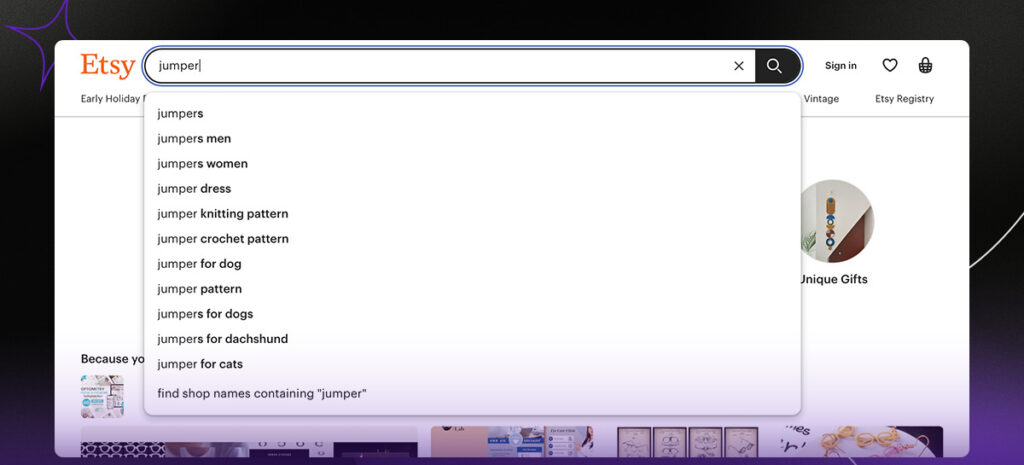
A keyword search must be carefully designed so that it returns relevant results. Keyword search should also capture synonyms for example, if the user searches for “Jumper”, “Sweater” or “Pullover”, these keywords should all return the same collection of items.
The more products or services that you need to search through, the longer it will take to run a search. To make sure that your search continues to run smoothly, you need to choose a high quality database to power your marketplace (e.g. PostgreSQL), a fast programming language to run the search (e.g. Google Go) & scalable hosting provider (e.g. Amazon Web Services or Google Cloud).
At Dittofi, we have marketplace templates that include both customizable categories and keyword search. You can see below an example of one such template for our rental marketplace solution. As you can see, this template is very similar to Airbnb. Categories are listed across the top of the page. Clicking on each category automatically runs a search & returns a subset of results.
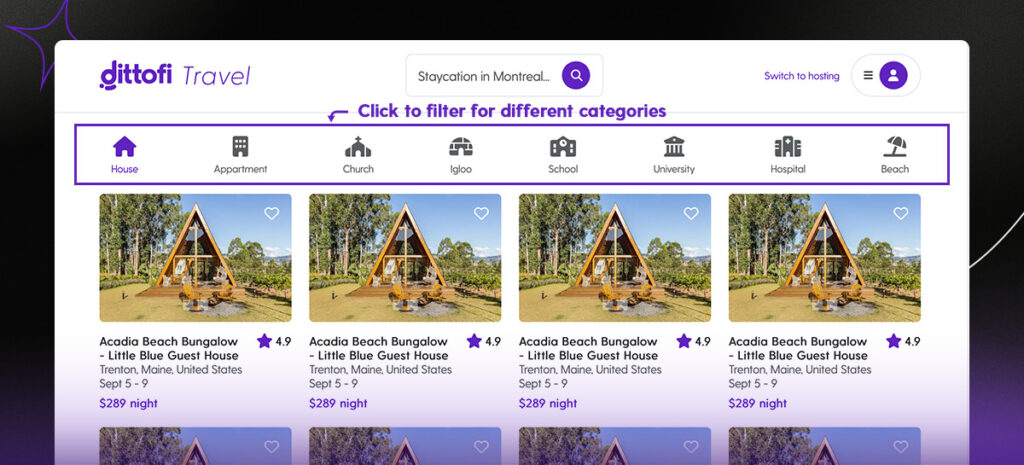
All templates in Dittofi comes with enterprise grade source code & a visual code editor which allows to update the code without a developer.
4. Routing pages (listing & listing results pages)
Routing pages – such as the listings page & the listings results page – plays a crucial role in product selection on marketplace sites. Below is the example from Fiverrs routing pages. On the left is the listings page & on the right is the listing results page.
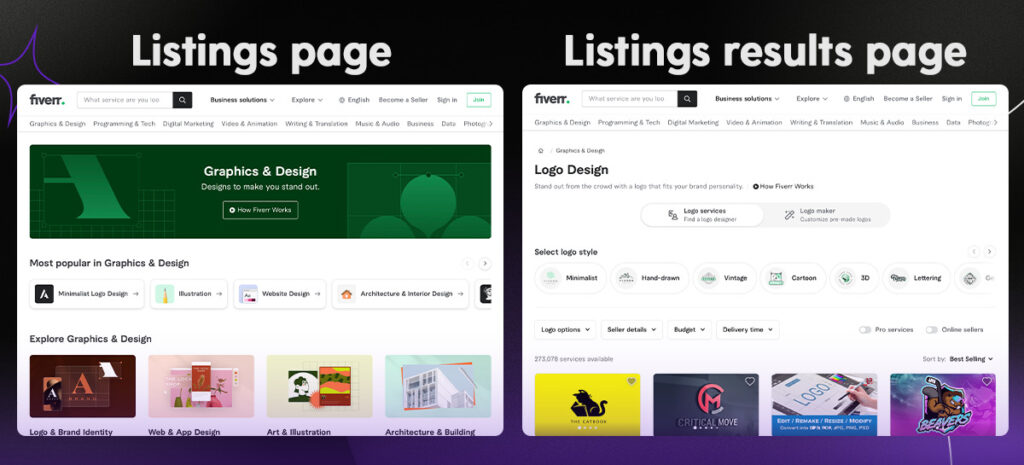
Listings & listing results pages organize and present multiple product and service options in a single page. They usually include useful sorting and filtering tools to help customers explore the different products and services. Listings and listing result pages on marketplaces sites often look very similar — on some sites, they’re identical.
The purpose of listing and listing results pages are so that customers can browse lists of products and services, compare options, bookmark favorites and make purchase decisions. Your listings and listing results pages should be designed to support these important tasks. To do this, you should make sure that your product and service photos are:
- Large & detailed – to give users a sense of the product
- Consistent – images should be consistent in style
- Specific – to reflect the users expressed interests
- Dynamic – showing multiple images to give additional context e.g. using a carousel
- Contextual – showing items in context e.g. clothing items being worn by models
- Inclusive – e.g. show items being used by models of diverse ages, races & sizes
Learn how to design high converting product listings pages.
Dittofi has developed several customizable listing pages & listing result page templates (see below). Each template has been optimized to promote product & service selection on your marketplace.
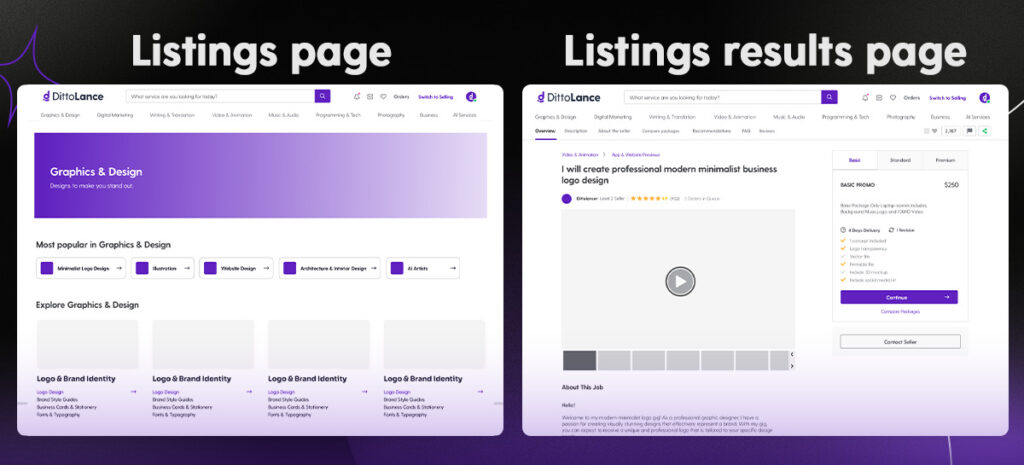
5. Listing details
When a buyer clicks on a listing they should be taken to the listing details page. At this point, the buyer has already expressed interest in the product. Therefore the goal of the listing details page is to help the buyer make a decision to purchase or rent the product or service.
The listing details page should be attractive, functional and maximize the potential for lead generation through public searches. To ensure this is the case, the listing details page should include clear titles & descriptions and be decorated with high resolution photos and rich media, such as videos, virtual tours. They can also be further enhanced with two sided reviews, the listing map location and neighborhood information.
Dittofi has several listing details pages that you can customize from within your online marketplace. These listing details pages include high-resolution photos (up to 800×800 pixels), option to add videos and virtual tours, both uploaded and embedded, Google Maps, Google Earth, Walk Score, custom listing banners, reviews, descriptions and more.
An example of one such listing details page is shown below.
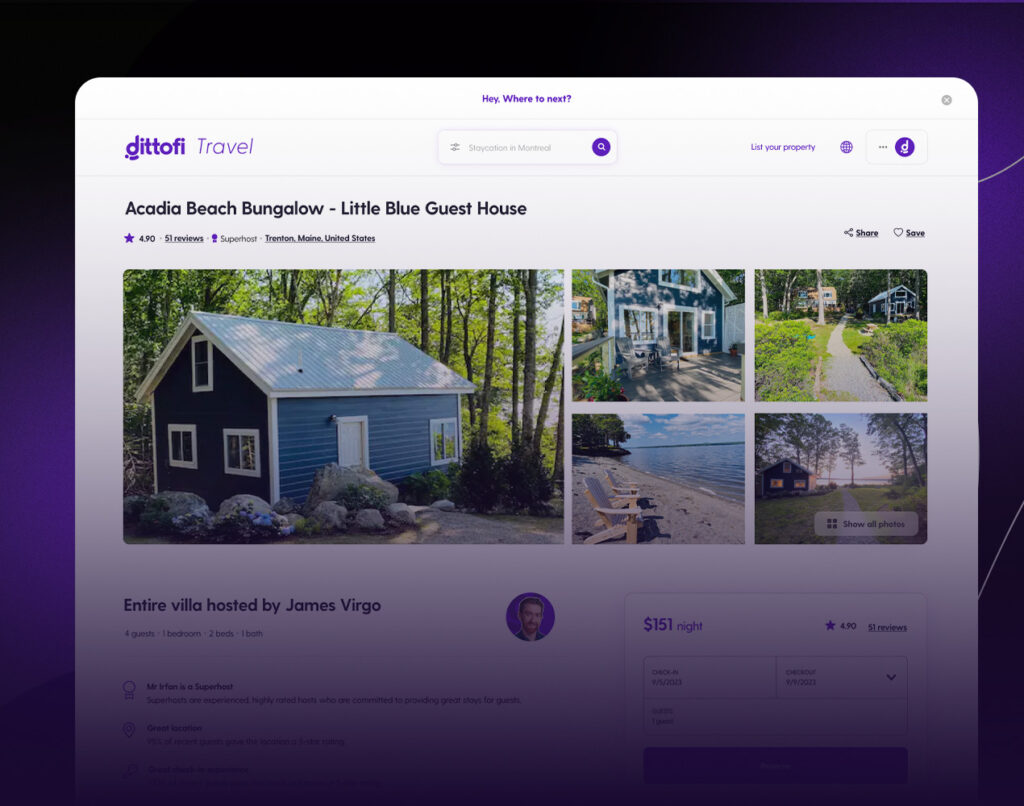
6. Payments integration
The purpose of an online marketplace business is to generate income for the platform & for your buyers & sellers. To do this, you need to choose a marketplace business model & integrate a method of taking payments on your platform.
Taking payments requires you to conform to a range of payment regulation that differ depending on local laws. This can make integrating payments into your platform highly complex. For example, as a marketplace you must take payments from your buyers & make payouts to your sellers. When you make payouts to your sellers, the payouts are subject to anti-money laundering and fraud-prevention measures.
To make things even more complex, most marketplaces take a commission on the transaction that takes place between the buyer & seller. This means that part of the payment goes to the seller & another to you as the platform operator. Notice that in this case, the payout to the seller cannot pass via the platform otherwise regulators consider that you are acting like a bank.
Marketplaces also need the to develop the functionality to offer secure payments, refunds & cancelations. Depending on the business model chosen, marketplaces may also need the ability to take one off payments, commission payments & subscription payments.
Building payments from scratch is therefore a highly complex process that requires experienced engineers to deliver correctly. There are off the shelf payment mechanism offered by ecommerce solutions however, these do not offer the payment features required for marketplaces.
Fortunately there are payment solutions like Stripe Connect that can be used to take marketplace payments. Although these solutions make developing marketplace payments much easier, they still require experienced developers to implement. By contrast, marketplace software, such as the marketplace solutions developed by Dittofi, enable you to simply use solutions like Stripe Connect without having to write absolutely any code.
7. User profiles
Profiles pages are automatically created when the user first signs up to your platform. The page will display personal details about the user. Buyers & sellers need to be able to add new & update personal information on their profiles pages. All of this needs to be done in a way that keeps the user data secure & is compliant with any legal requirements such as GDPR.
The primary purpose of the User Profiles page is to promote trust in the buyers and sellers. The more complete a user’s profile is, the more likely that other users transact with them. To help with this, the profile pages should include username, full name, photographs, lists of previous transactions, reviews & (optionally) ID verification badges (badges that the marketplace can award to say that the user’s identification has been verified).
Depending on the type of marketplace that you’re developing, you may need to develop different profile pages for buyers and sellers. For example, if the buyers on your marketplace are businesses, then you may want to create a business profile page.
As the marketplace owner, you also need the ability to verify, ban and delete user accounts from your system (more on marketplace admin features later).
Dittofi has developed template profile pages for marketplaces. You can see examples of these below. Each page can be customized and extended within Dittofi’s visual development studio, without needing to write any code.
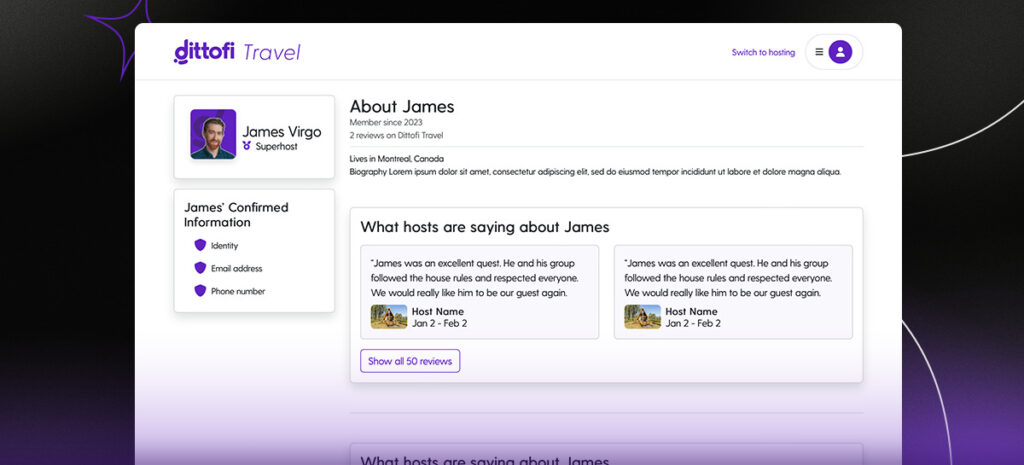
8. Manage listings
The “manage listing page” on a two-sided marketplace serves as a dashboard for users (typically sellers) to control and administer their listings, products, services, or offerings on the platform. Its primary purpose is to empower sellers with tools and features to efficiently manage and optimize their offerings.
There is a standard set of functionality that manage listing pages should have. This includes:
- Create and edit listings
- Inventory management
- Order management
- Pricing and promotion
- Real-time messaging
- Visibility and ranking
- Custom reviews and ratings
- Upload and manage media
Server and rental marketplaces have additional feature requirements such as appointment scheduling and booking and calendar management.
At Dittofi we have developed fully functional “Manage Listing Page” templates. These include the standard listing functionality off the shelf that can be augmented with new features to help your specific vendors better manage their listings better. You can see some examples of these templates below.
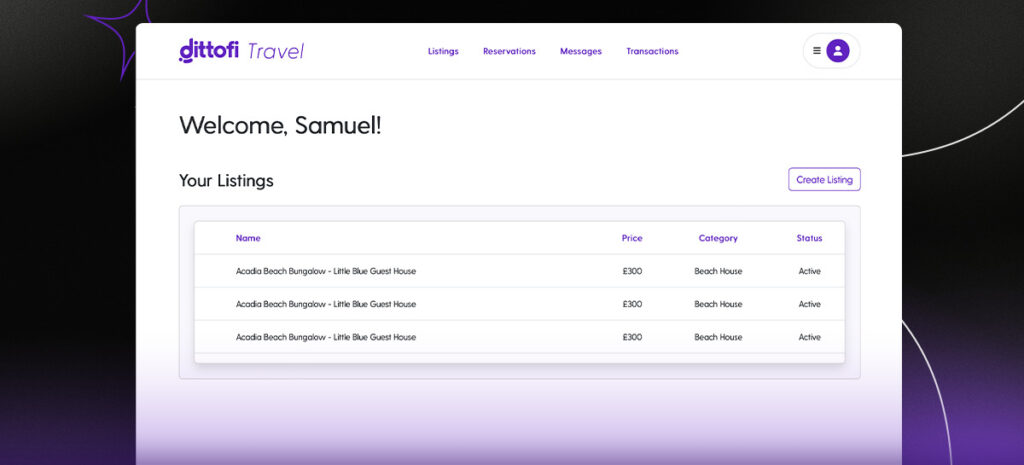
9. On-platform communication
Buyers & sellers must be able to communicate with each other on the platform.
If users communicate off platform this can lead to marketplace leakage where buyers and sellers meet on the platform, but transact off the platform. Marketplace leakage can cause massive loss in revenue for the marketplace. Although on-platform communication can help keep buyers and sellers transacting on the platform, generally speaking, the best way to prevent marketplace leakage is to provide more value on your marketplace.
On-platform communication is typically achieved by developing an in app chat functionality. The in app chat functionality can include various features such as:
- Read receipts
- Ability to chat one on one or in a group
- Tie the chat directly to a transaction
- Chat audit trail to aid in dispute resolution
- Auto translate for users transacting in different languages
- Auto detect the sharing of phone numbers or email addresses between marketplace participants.
- Automatic notifications when a user makes a sale, receives a booking or gets a review.
If you’re coding your chat from scratch, then each additional feature will need to be coded. This can increase the price, time & complexity of the development. In contrast, Dittofi has prebuilt chat modules that you can use directly in your marketplace (see an example below).
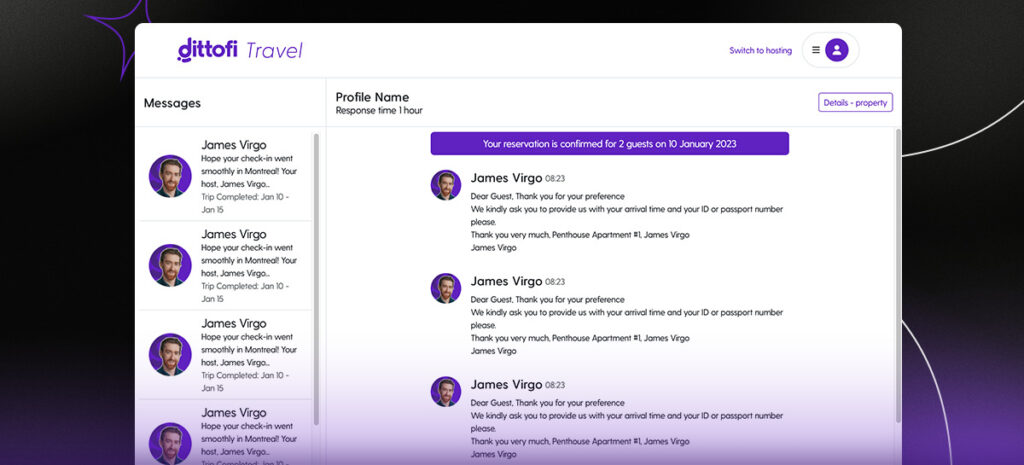
10. Reviews
One of the hardest things to do when launching a new marketplace is to build trust between buyers & sellers. One simple way to boost trust is a reviews feature. Sellers that have a large number of positive reviews will generally sell more compared to sellers without reviews.
On certain marketplaces vendors also need a way to review their customers. For example, consider rental marketplaces like Airbnb or Turo. In these marketplace, vendors allow strangers to rent their assets for a set period of time. Vendors need to be careful not to allow just anyone to rent their property, since strangers may damage or steal their property. When both counterparties review each other, this is known as two-sided reviews.
One thing to look out for when designing the review mechanism for your marketplace is the potential for buyers and sellers to threaten to leave bad reviews if they don’t get what they want. There are various ways to get around this, for example, using a double blind review process where each counterparty can leave a review without the other knowing what was said. The reviews are then only made visible after both sides have left their review.
Other methods that you can use to promote the use of fair reviews on your marketplace include:
- Let your users know why reviews are important.
- Automatically notify & remind users to leave a review once a transaction has completed.
- Have a dispute resolution process for when one or both counterparties to a transaction want to dispute a bad review.
- Remind users to communicate on the platform so that there is a clear audit trail of communications between the buyers & sellers.
- Build a mechanism for counterparties to provide proof if they want to dispute a bad review.
11. Search engine optimization
When you search for a product or service to buy, you have two choices: (1) use a search engine e.g. Google, Bing, Yahoo, or (2) make a trip to a physical store.
Nowadays more than 80% of consumers buy online & more than 80% of consumers use search engines to find the products & services that they want to buy. This makes it absolutely critical that your online marketplace can be found by consumers using search engines like Google.
For example, let’s say that I need to hire a graphic designer. I might go to Google & search for “hire a freelance graphic designer”. This returns the following search results.
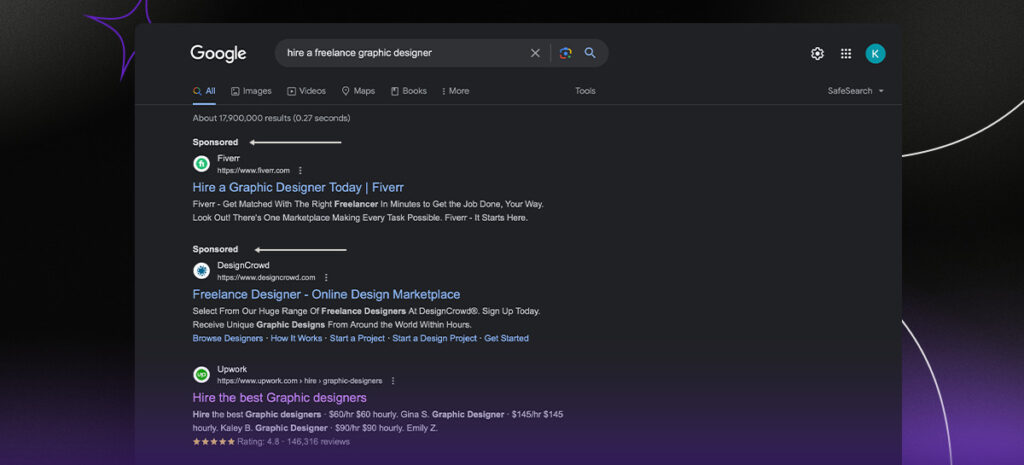
As you can see, at the top, there are two Sponsored ads. One for the freelance marketplace Upwork and below that a competitor site DesignCrowd.
Below the sponsored ads, there are links to web pages that Google determines relevant to my search. These are known as organic search results. In our example, there is a link to the freelancer marketplace Upwork & if I scroll down a bit, you will see other freelance marketplaces Fiverr, Toptal & some other design services.
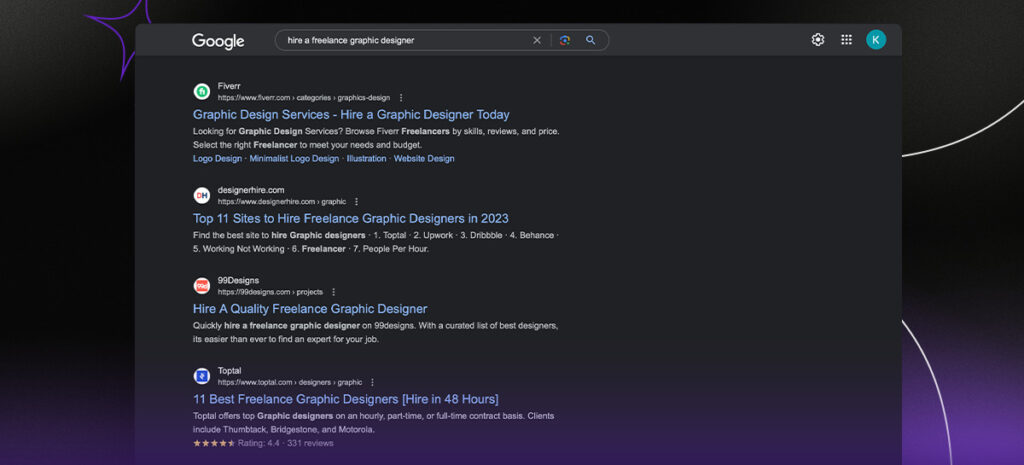
How does Google know that this page is relevant to my search? And why does Google place Fiverr at the top of the organic search results?
There are several factors that search engines look at to determine what results are displayed on the first page. To make sure that you appear on the first page, you need strong technical SEO such as fast page load speed, page structure (correctly using meta tags) & so on.
The top marketplaces today such as Airbnb, Fiverr, Etsy & so on, all use a technology called React. React is a technology developed by Facebook and gives you a highly performant frontend that can be optimized for search engines.
Dittofi has developed several simple React marketplace templates that are optimized for search engines and that you can customize for your marketplace. These include templates for service, rental and product marketplaces like Fiverr, Airbnb and Etsy. Each template is free inside of Dittofi and can be customized using Dittofi’s visual app builder, without writing any code.
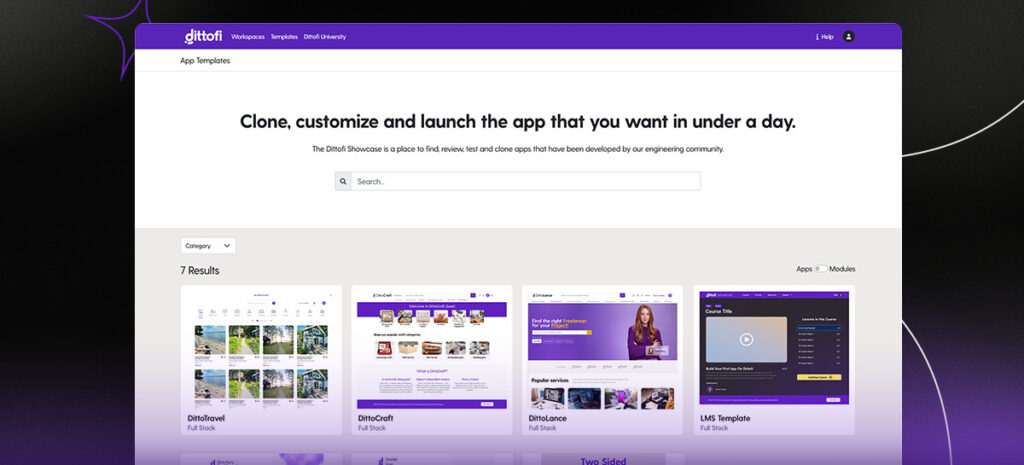
In addition to building a page that is designed to perform well on search engines, you may also wish to consider setting up paid for search.
12. Marketplace hosting & data security
Your marketplace should be available for users to access 24/7. Ideally you want to run your marketplace on a specialized hosting service so that you don’t have to worry about server maintenance, security or hardware upgrades. Dittofi offers one such hosting service called the Dittofi Cloud.
You may also want to consider setting up your own hosting environment. This can help you save a lot of money when it comes to running your marketplace.
Nowadays, many companies that run their own hosting environments choose to run their marketplaces in the cloud. To do this, you need to work with a cloud service provider such as Google Cloud, Microsoft Azure or Amazon Web Services. Each of these providers offers a collection of services called “cloud services”. Cloud services are like apps that run on your smartphone. Each cloud service provides a specialist set of functionality that you can use to scale your technology in a fast, secure & low cost way.
The challenge for many small businesses is that finding engineers that know how to use the cloud. These engineers are incredibly difficult to find and are very expensive. Dittofi has a solution here called Dittofi ADS that allows you to host your marketplace inside your own hosting environment in a single click and without having to write any code. This allows you to get access to have your marketplace running on your own infrastructure without having to actually build it yourself.
Features for specific types of marketplace
There are three main types of marketplace: product, service & rental. Although each of these marketplaces will require the common list of features detailed in the previous section, there are key differences in the features required for each. We detail these differences in this section.
Product Marketplace
Product marketplaces connect sellers of physical goods with buyers. Often these marketplaces start with one niche category of product & then expand to include complementary products.
One of the most popular product marketplaces is eBay, which started as a marketplace for collectors of unique & rare items such as Pez dispensers & Beanie Babies. There are now more than 300 categories on eBay with more than 1.7 billion listings.
Successful product marketplaces have several features that other online marketplaces don’t need. These include:
Inventory management
Sellers on product marketplaces have limited amounts of inventory or stock. Once their stock is sold, they no longer have any product to sell. By providing your sellers with the tools to manage their inventory, you will avoid the situation where buyers become frustrated by purchasing products that are not available.
Inventory management tools are also a great way to provide value in your marketplace above & beyond what is offered by your competitors. A good suite of inventory management tools may lead to sellers using your marketplace software even when there are no buyers. This is one way to solve the marketplace chicken and egg problem.
Shipping & returns
On most marketplaces, it is the sellers responsibility to ship the product to the customer who purchased the product. This means that you need features for your customers to choose between shipping & pickup & for the customer to provide their shipping address.
You also need features for the sellers to include a shipping fee in the price of their product & the option to mark the item as shipped. Choosing the shipping method is then left to the discretion of the seller. Once the seller has marked the item as shipped, the buyer should then get a notification, with the option to track the order (if this is offered by the seller’s choice of shipping method).
Finally, you will need features for sellers to set their own return policies & instructions on how to return an item & getting a refund.
Normally this set of features is more than enough for early stage product marketplaces. In the future, you may decide to integrate with a full-fledged shipping service provider such as UPS, FedEx, DHL, to make the shipping returns process smoother.
Shopping carts
If you expect that your users are going to purchase multiple items in one go, then you can consider adding shopping cart functionality to your marketplace website. Platforms such as Ebay, Amazon & Etsy all have their own shopping carts.
Building a shopping cart can be complex, time consuming & expensive. You need to create a lot of features for the shopping cart such as the ability to activate users who leave items in their shopping cart without paying & so on. Therefore, think very carefully if you actually need to build a shopping cart from scratch.
Dittofi offers a shopping cart solution directly off the shelf, so that you can include it in your products marketplace in just one click. The solution comes with all of the code to run the shopping cart that you can edit with Dittofi’s visual development studio or export & give to a developer.
Service marketplace
A service marketplace allows buyers to purchase services from a community of sellers. Service marketplaces can offer any service such as hiring a dog walker, a software developer or healthcare professionals offering telemedicine consultations.
There are many examples of successful service marketplaces that you can look at for inspiration like Fiverr, Upwork, Thumbtack & TaskRabbit. In addition to the core marketplace features, successful service marketplaces have several essential features that other types of marketplaces don’t have. These include:
Appointment scheduling
Service marketplaces often require scheduling capabilities to allow users to book specific time slots for services like appointments, consultations, or lessons. In these instances, it can be useful to integrate with a calendar system such as iCalendar (iCal) to show service providers’ availability and allow users to choose suitable time slots.
For example, the service marketplace Cleanster allows airbnb hosts to automatically schedule cleaners based on when their guests checkout. This is a feature that differentiates Cleanser from other service marketplaces in the same space.
Service verification
Service marketplaces in fields such as healthcare, legal or education, require service providers’ to submit professional qualifications, credentials or licenses. Oftentimes marketplaces will start off by manually verifying a service provider’s paperwork. As the marketplace expands however, it is critical that you integrate with tools such as Certn & find ways to automatically verify that your users are submitting the correct paperwork.
Note, running background checks costs money. Therefore, you need to make sure that when you run a background check the service provider is quickly activated on your marketplace. Otherwise, you’ll have paid for their background check for nothing.
Rental marketplace
A rental marketplace is an online platform that connects people who want to rent or lease items, properties, or equipment with those who have such items available for temporary use in exchange for a fee. Rental marketplaces can offer many different types of equipment such as vacation homes, construction equipment, party supplies & so on.
There are many examples of successful rental marketplaces that you can look at for inspiration like Airbnb, Turo, Getaround & Zillow. In addition to the core marketplace features, rental marketplaces also require niche features such as:
Additional trust building features
On rental marketplaces, renters are often renting out valuable property such as cars, homes or specialized equipment. This means that it is extremely important to build strong trust between buyers and sellers.
In addition to two-sided, double blind reviews, there are several other trust mechanisms that you can incorporate into your rental marketplace. These include, taking security deposits to protect owners against damages, taking sellers through additional ownership verification steps & investigating insurance & liability coverage for both buyers & sellers.
Booking & calendar availability
Rental marketplaces often need sophisticated calendar systems to manage booking periods and availability of items or properties.
It can help to integrate calendars with other systems that are already used by your marketplace vendors. For example, Airbnb integrates with property management systems such as Hostaway. By integrating with tools that are already familiar to your user base, this can improve user adoption of your marketplace.
Location search
Most rental marketplaces need a location based search. For example, Airbnb’s guests need to find rental properties within the city they’re planning to visit, Turo guests need to be able to find rental vehicles nearby and so on.
It is usually the case that rental marketplaces will have two levels of location based search. Level 1 provides the approximate location of the seller’s item. This way the marketplace does not give away exact details of the seller’s item which would be a security risk. Then, once the item has been reserved, the marketplace will then provide the specific location for the buyer needs in order to check-in to the property or pick up the item they’re renting.
Final Thoughts: How to build an online marketplace
Building a marketplace business is a complex and time consuming process. It can take a few weeks just to understand what features are required for version one of your marketplace. Although it is a lot of information to take in, the best way to build a successful marketplace is to take the time to fully understand what you’re about to develop.
After you’ve listed out the required features, the next step is to start building your marketplace. Building a basic marketplace, with code and from scratch will cost more than $100,000. This is a lot of money especially if you are not sure if your marketplace will be successful or not. Furthermore, it’s very hard to find a team of developers who you can trust to build a marketplace that actually works. There are plenty of horror stories of developers misunderstanding requirements and developing an ecommerce platform rather than a two-sided marketplace.
One way to speed up the development of your marketplace is with the use of marketplace technologies however, these require developers to operate, they are often very limited and they come with full vendor lock-in. This means that you don’t actually own the underlying source code or intellectual property that your marketplace runs on.
At Dittofi, we provide you with carefully designed marketplace solutions that you can rapidly customize from within our visual development studio & without writing code. We then translate the visual designs into enterprise grade code (React & Google Go) that you can launch in one click onto our fully scalable hosting environment or export and give to a developer.
Using Dittofi, you are able to build & launch a custom marketplace without writing any code in just 2 – 4 weeks. You can then use Dittofi’s visual development studio to rapidly build new features for your marketplace users.
The key to building a successful marketplace is to launch your marketplace as early as possible, engage with customers on your marketplace & then to build features that your customers ask for. Book a call to consult with one of our marketplace specialists or sign up to Dittofi’s visual development studio & build your marketplace today.
Become a Marketplace Insider
Join our inner circle for exclusive insights, coveted trade secrets, and unparalleled strategies – your journey to marketplace dominance begins here.

